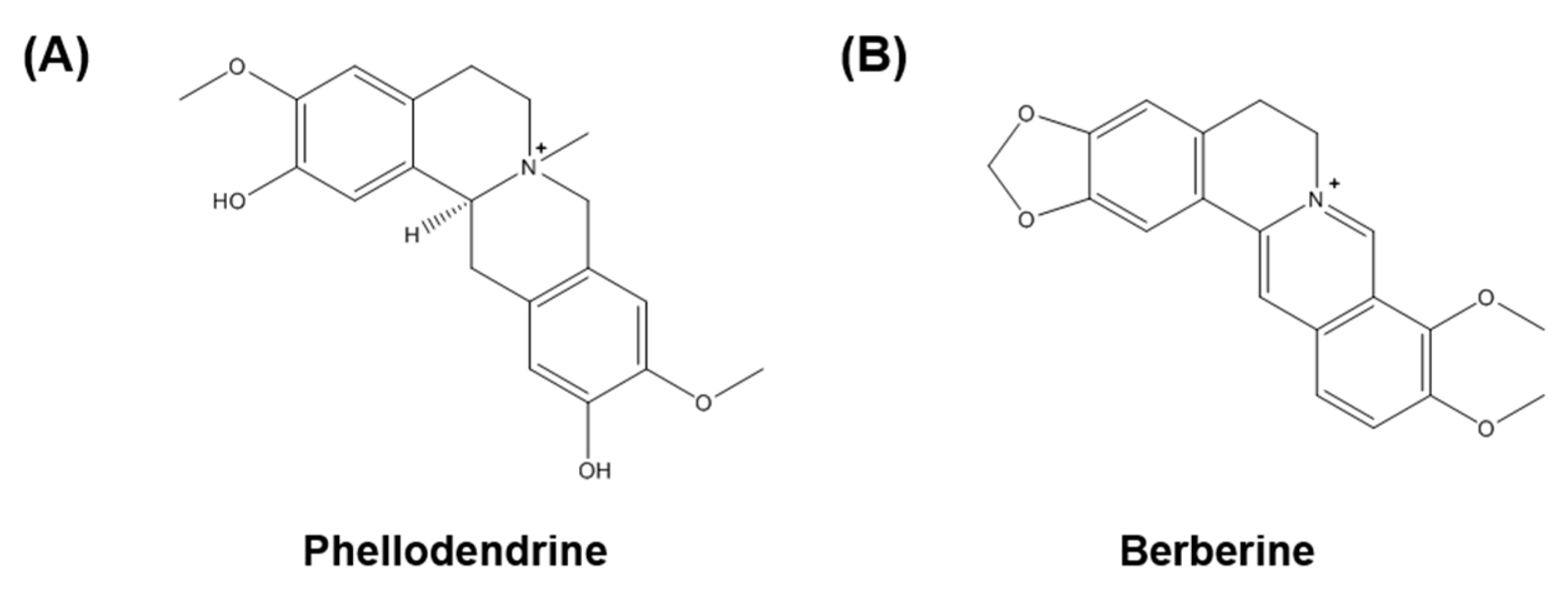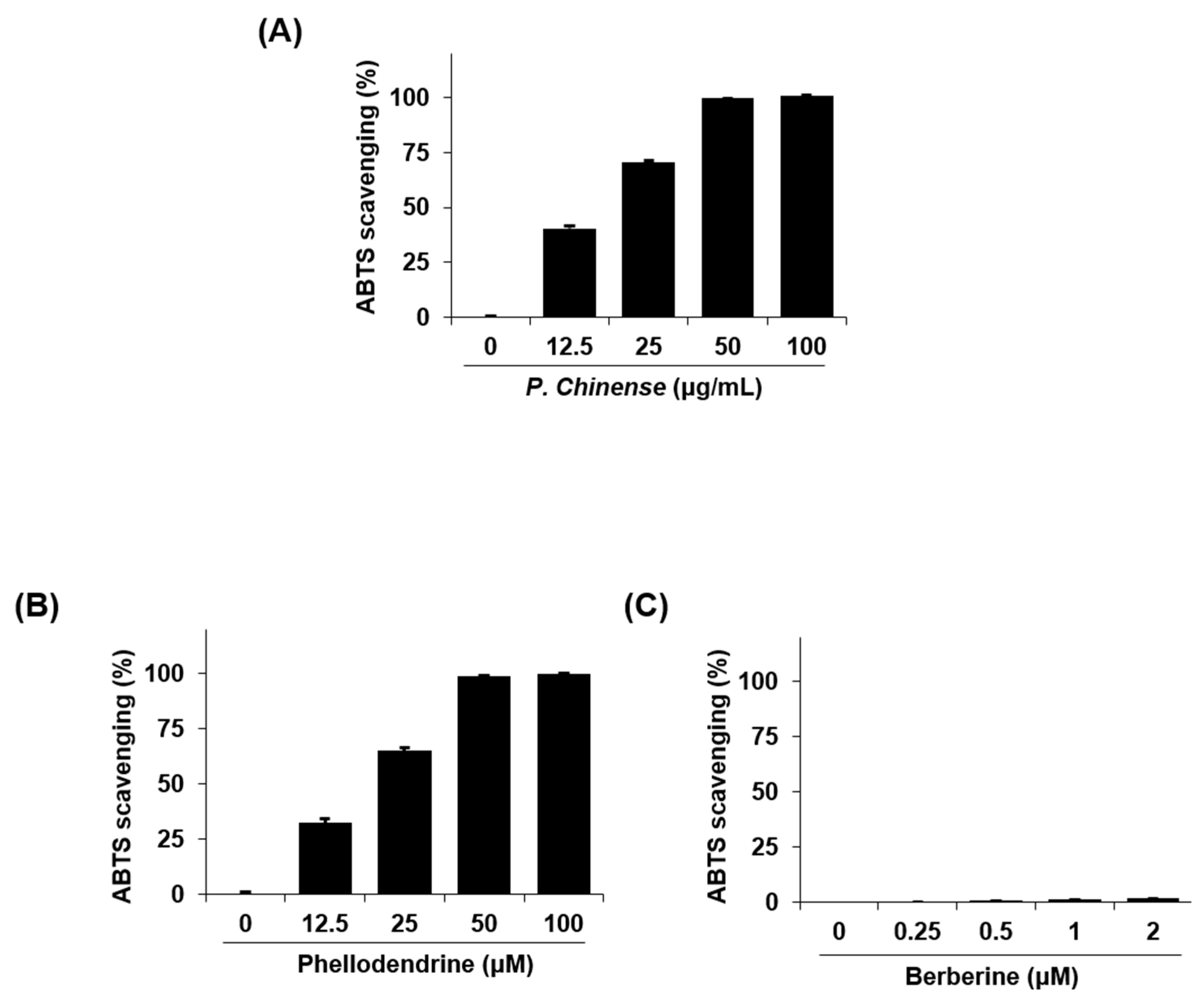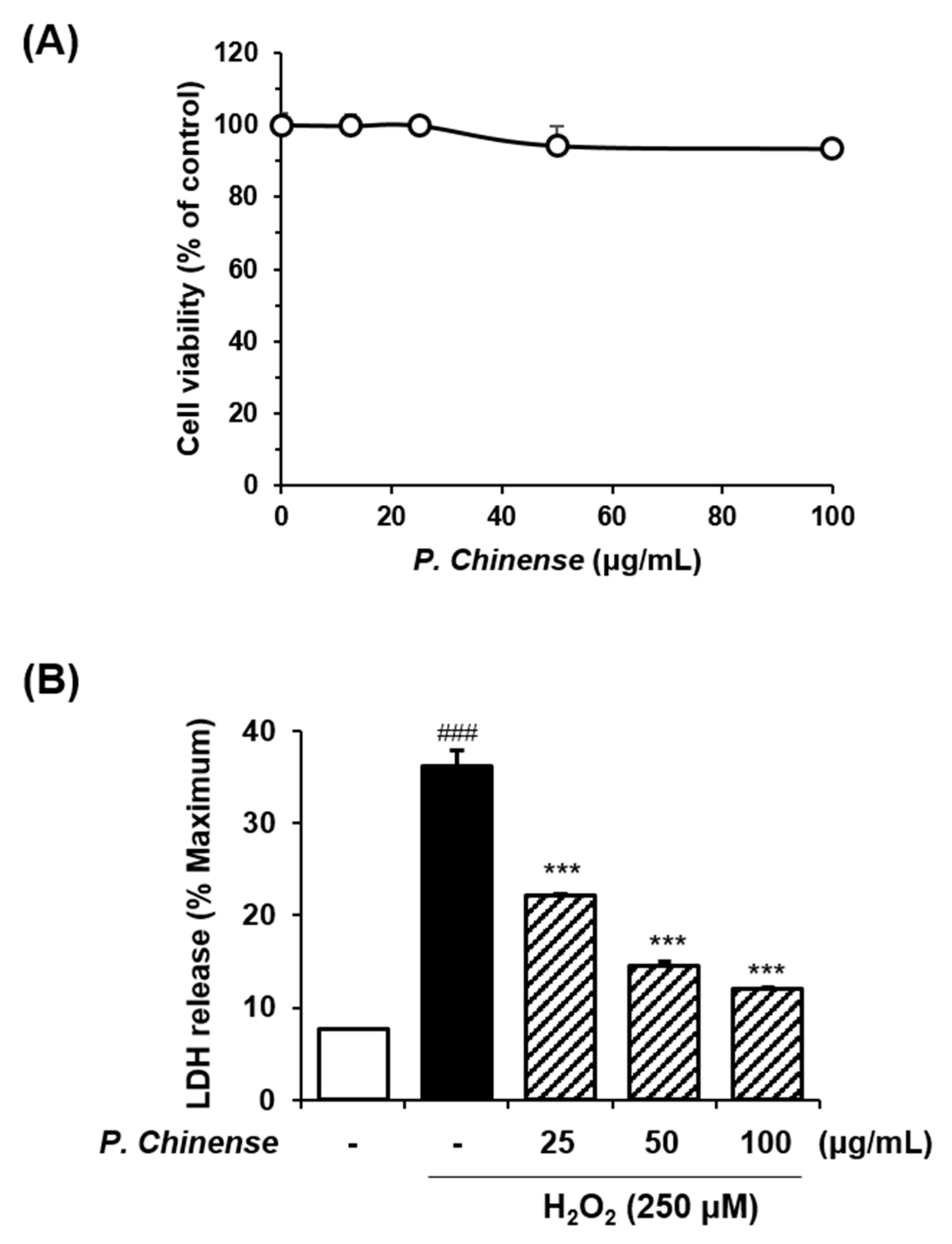Phytochemical Quantification and the In Vitro Acetylcholinesterase Inhibitory Activity of Phellodendron chinense and Its Components
Abstract
:1. Introduction
2. Results
2.1. Optimization of HPLC Separation
2.2. Linearity, Limit of Detection (LOD), and Limit of Quantitation (LOQ)
2.3. Determination of the Two Standard Components of P. chinense
2.4. Inhibitory Effects of the P. chinense Extract and Its Standard Components on AChE Activity
2.5. Antioxidant Activity of the P. chinense Extract and Its Standard Components
2.6. Neuroprotective Effects of the P. chinense Extract in HT22 Neuronal Cells
3. Discussion
4. Materials and Methods
4.1. Plant Material
4.2. Chemicals and Reagents
4.3. Apparatus and Chromatographic Conditions
4.4. Preparation of Standard Solutions
4.5. Preparation of Sample Solutions
4.6. Calibration Curves and Limits of Detection and Quantification
LOQ = 10 × (SD of the response/slope of the calibration curve).
4.7. In Vitro AChE Activity Assay
- S: samples (sample solution, assay buffer with DTNB, substrate, and enzyme)
- S’: samples (sample solution, assay buffer with DTNB and substrate, without enzyme)
- C: control (0.1 M sodium phosphate buffer (pH 8.0), assay buffer with DTNB, substrate, and enzyme)
- C’: control (0.1 M sodium phosphate buffer (pH 8.0), assay buffer with DTNB and substrate, without enzyme)
4.8. In Vitro Amyloid-β Aggregation Assay
- S: samples (sample solution, assay buffer with ThT, amyloid-β solution)
- S’: samples (sample solution, assay buffer with ThT, without amyloid-β solution)
- C: control (assay buffer with ThT, amyloid-β solution)
- C’: control (assay buffer with ThT, without amyloid-β solution)
4.9. ABTS Radical Scavenging Activity
4.10. CCK Assay
4.11. LDH Release Assay
4.12. Statistical Analysis
Acknowledgments
Author Contributions
Conflicts of Interest
References
- World Health Organization. Dementia Fact Sheet N°362; World Health Organization: Geneva, Switzerland, 2015. [Google Scholar]
- Burns, A.; Iliffe, S. Alzheimer’s disease. BMJ 2009, 338. [Google Scholar] [CrossRef] [PubMed]
- Ballard, C.; Gauthier, S.; Corbett, A.; Brayne, C.; Aarsland, D.; Jones, E. Alzheimer’s disease. Lancet 2011, 377, 1019–1031. [Google Scholar] [CrossRef]
- World Health Organization. The Top 10 Causes of Death Fact Sheet; World Health Organization: Geneva, Switzerland, 2017. [Google Scholar]
- Bartus, R.T. On neurodegenerative diseases, models, and treatment strategies: Lessons learned and lessons forgotten a generation following the cholinergic hypothesis. Exp. Neurol. 2000, 163, 495–529. [Google Scholar] [CrossRef] [PubMed]
- Selkoe, D.J.; Hardy, J. The amyloid hypothesis of Alzheimer’s disease at 25 years. EMBO Mol. Med. 2016, 8, 595–608. [Google Scholar] [CrossRef] [PubMed]
- Qiu, T.Y.; Chang, D.L.; Tang, J.W. Wood anatomical properties of Phellodendron chinense var. glabriusculum. J. Northeast For. Univ. 2006, 34, 36–38. [Google Scholar]
- Yan, C.; Wang, Y.; Hao, X.J. Triterpenes from the fruits of Phellodendron chinense Schneid var. glabriusculum Schneid. Chin. J. Nat. Med. 2009, 7, 31–33. [Google Scholar] [CrossRef]
- Park, S.D.; Lai, Y.S.; Kim, C.H. Immunopontentiating and antitumor activities of the purified polysaccharides from Phellodendron chinese Schneid. Life Sci. 2004, 75, 2621–2632. [Google Scholar] [CrossRef] [PubMed]
- Yan, C.; Zhang, Y.D.; Wang, X.H.; Geng, S.D.; Wang, T.Y.; Sun, M.; Liang, W.; Zhang, W.Q.; Zhang, X.D.; Luo, H. Tirucallane-type triterpenoids from the fruits of Phellodendron chinense Schneid and their cytotoxic activities. Fitoterapia 2016, 113, 132–138. [Google Scholar] [CrossRef] [PubMed]
- Zheng, L.; Sidike, G.M.; Zhang, Y.M. Study on antitumor effect of wutousan. Zhong Yao Cai 2013, 36, 1301–1304. [Google Scholar] [PubMed]
- Xian, Y.F.; Mao, Q.Q.; Ip, S.P.; Lin, Z.X.; Che, C.T. Comparison on the anti-inflammatory effect of Cortex Phellodendri chinensis and Cortex Phellodendri amurensis in 12-O-tetradecanoyl-phorbol-13-acetate-induced ear edema in mice. J. Ethnopharmacol. 2011, 137, 1425–1430. [Google Scholar] [CrossRef] [PubMed]
- Zhang, Q.; Li, Y.; Chen, L. Effect of berberine in treating type 2 diabetes mellitus and complications and its relevant mechanisms. Zhongguo Zhong Yao Za Zhi 2015, 40, 1660–1665. [Google Scholar] [PubMed]
- Ye, L.; Qian, J.; Jin, S.; Zuo, S.; Mei, H.; Ma, S. Algicidal effects of four Chinese herb extracts on bloom-forming Microcystis aeruginosa and Chlorella pyrenoidosa. Environ. Technol. 2014, 35, 1150–1156. [Google Scholar] [CrossRef] [PubMed]
- Xian, Y.F.; Lin, Z.X.; Ip, S.P.; Su, Z.R.; Chen, J.N.; Lai, X.P. Comparison of the neuroprotective effect of Cortex Phellodendri chinensis and Cortex Phellodendri amurensis against beta-amyloid-induced neurotoxicity in PC12 cells. Phytomedicine 2013, 20, 187–193. [Google Scholar] [CrossRef] [PubMed]
- Li, L.; Huang, T.; Tian, C.; Xiao, Y.; Kou, S.; Zhou, X.; Liu, S.; Ye, X.; Li, X. The defensive effect of phellodendrine against AAPH-induced oxidative stress through regulating the AKT/NF-kappaB pathway in zebrafish embryos. Life Sci. 2016, 157, 97–106. [Google Scholar] [CrossRef] [PubMed]
- Mori, H.; Fuchigami, M.; Inoue, N.; Nagai, H.; Koda, A.; Nishioka, I. Principle of the bark of Phellodendron amurense to suppress the cellular immune response. Planta Med. 1994, 60, 445–449. [Google Scholar] [CrossRef] [PubMed]
- Mori, H.; Fuchigami, M.; Inoue, N.; Nagai, H.; Koda, A.; Nishioka, I.; Meguro, K. Principle of the bark of Phellodendron amurense to suppress the cellular immune response: Effect of phellodendrine on cellular and humoral immune responses. Planta Med. 1995, 61, 45–49. [Google Scholar] [CrossRef] [PubMed]
- Dong, H.; Wang, N.; Zhao, L.; Lu, F. Berberine in the treatment of type 2 diabetes mellitus: A systemic review and meta-analysis. Evid. Based Complement. Altern. Med. 2012, 2012, 591654. [Google Scholar] [CrossRef] [PubMed]
- Wang, Y.; Yi, X.; Ghanam, K.; Zhang, S.; Zhao, T.; Zhu, X. Berberine decreases cholesterol levels in rats through multiple mechanisms, including inhibition of cholesterol absorption. Metab. Clin. Exp. 2014, 63, 1167–1177. [Google Scholar] [CrossRef] [PubMed]
- Wang, H.Y.; Yu, H.Z.; Huang, S.M.; Zheng, Y.L. p53, Bcl-2 and cox-2 are involved in berberine hydrochloride-induced apoptosis of HeLa229 cells. Mol. Med. Rep. 2016, 14, 3855–3861. [Google Scholar] [PubMed]
- Wang, N.; Wang, X.; Tan, H.Y.; Li, S.; Tsang, C.M.; Tsao, S.W.; Feng, Y. Berberine suppresses cyclin D1 expression through proteasomal degradation in human hepatoma cells. Int. J. Mol. Sci. 2016, 17, 1899. [Google Scholar] [CrossRef] [PubMed]
- Zhuo, Y.; Chen, Q.; Chen, B.; Zhan, X.; Qin, X.; Huang, J.; Lv, X. Berberine promotes antiproliferative effects of epirubicin in T24 bladder cancer cells by enhancing apoptosis and cell cycle arrest. Int. J. Clin. Pharmacol. Ther. 2017, 55, 32–40. [Google Scholar] [CrossRef] [PubMed]
- Kaufmann, D.; Kaur Dogra, A.; Tahrani, A.; Herrmann, F.; Wink, M. Extracts from traditional Chinese medicinal plants inhibit acetylcholinesterase, a known Alzheimer’s disease target. Molecules 2016, 21, 1161. [Google Scholar] [CrossRef] [PubMed]
- Martorana, A.; Esposito, Z.; Koch, G. Beyond the cholinergic hypothesis: Do current drugs work in Alzheimer’s disease? CNS Neurosci. Ther. 2010, 16, 235–245. [Google Scholar] [CrossRef] [PubMed]
- Lahiri, D.K.; Farlow, M.R.; Greig, N.H.; Sambamurti, K. Current drug targets for Alzheimer’s disease treatment. Drug Dev. Res. 2002, 56, 267–281. [Google Scholar] [CrossRef]
- Saleem, H.; Ahmad, I.; Shahid, M.N.; Gill, M.S.; Nadeem, M.F.; Mahmood, W.; Rashid, I. In vitro acetylcholinesterase and butyrylcholinesterase inhibitory potentials of Jatropha gossypifolia plant extracts. Acta Pol. Pharm. 2016, 73, 419–423. [Google Scholar] [PubMed]
- Yang, Y.; Cheng, X.; Liu, W.; Chou, G.; Wang, Z.; Wang, C. Potent AChE and BChE inhibitors isolated from seeds of Peganum harmala Linn by a bioassay-guided fractionation. J. Ethnopharmacol. 2015, 168, 279–286. [Google Scholar] [CrossRef] [PubMed]
- Sadigh-Eteghad, S.; Sabermarouf, B.; Majdi, A.; Talebi, M.; Farhoudi, M.; Mahmoudi, J. Amyloid-beta: A crucial factor in Alzheimer’s disease. Med. Princ. Pract. 2015, 24, 1–10. [Google Scholar] [CrossRef] [PubMed]
- Huang, W.J.; Zhang, X.; Chen, W.W. Role of oxidative stress in Alzheimer’s disease. Biomed. Rep. 2016, 4, 519–522. [Google Scholar] [CrossRef] [PubMed]
- Apetz, N.; Munch, G.; Govindaraghavan, S.; Gyengesi, E. Natural compounds and plant extracts as therapeutics against chronic inflammation in Alzheimer’s disease—A translational perspective. CNS Neurol. Disord. Drug Targets 2014, 13, 1175–1191. [Google Scholar] [CrossRef] [PubMed]
- Wang, Z.Y.; Liu, J.G.; Li, H.; Yang, H.M. pharmacological effects of active components of Chinese herbal medicine in the treatment of Alzheimer’s disease: A review. Am. J. Chin. Med. 2016, 44, 1525–1541. [Google Scholar] [CrossRef] [PubMed]
- Abd El-Wahab, A.E.; Ghareeb, D.A.; Sarhan, E.E.; Abu-Serie, M.M.; El Demellawy, M.A. In vitro biological assessment of Berberis vulgaris and its active constituent, berberine: Antioxidants, anti-acetylcholinesterase, anti-diabetic and anticancer effects. BMC Complement. Altern. Med. 2013, 13, 218. [Google Scholar] [CrossRef] [PubMed]
- Shirwaikar, A.; Shirwaikar, A.; Rajendran, K.; Punitha, I.S. In vitro antioxidant studies on the benzyl tetra isoquinoline alkaloid berberine. Biol. Pharm. Bull. 2006, 29, 1906–1910. [Google Scholar] [CrossRef] [PubMed]
- Jang, M.H.; Kim, H.Y.; Kang, K.S.; Yokozawa, T.; Park, J.H. Hydroxyl radical scavenging activities of isoquinoline alkaloids isolated from Coptis chinensis. Arch. Pharm. Res. 2009, 32, 341–345. [Google Scholar] [CrossRef] [PubMed]
- Fukutani, Y.; Cairns, N.J.; Shiozawa, M.; Sasaki, K.; Sudo, S.; Isaki, K.; Lantos, P.L. Neuronal loss and neurofibrillary degeneration in the hippocampal cortex in late-onset sporadic Alzheimer’s disease. Psychiatry Clin. Neurosci. 2000, 54, 523–529. [Google Scholar] [CrossRef] [PubMed]
- Zhao, Z.Y.; Luan, P.; Huang, S.X.; Xiao, S.H.; Zhao, J.; Zhang, B.; Gu, B.B.; Pi, R.B.; Liu, J. Edaravone protects HT22 neurons from H2O2-induced apoptosis by inhibiting the MAPK signaling pathway. CNS Neurosci. Ther. 2013, 19, 163–169. [Google Scholar] [CrossRef] [PubMed]
- Vedder, H.; Teepker, M.; Fischer, S.; Krieg, J.C. Characterization of the neuroprotective effects of estrogens on hydrogen peroxide-induced cell death in hippocampal HT22 cells: Time and dose-dependency. Exp. Clin. Endocrinol. Diabetes 2000, 108, 120–127. [Google Scholar] [CrossRef] [PubMed]
- Ellman, G.L.; Courtney, K.D.; Andres, V., Jr.; Feather-Stone, R.M. A new and rapid colorimetric determination of acetylcholinesterase activity. Biochem. Pharmacol. 1961, 7, 88–95. [Google Scholar] [CrossRef]
Sample Availability: Samples of the compounds phellodendrine and berberine are commercially available. |





| Time (min) | Flow Rate (mL/min) | Mobile Phase | |
|---|---|---|---|
| 0.1% Trifluoroacetic Acidin Water (%) | Acetonitrile (%) | ||
| 0 | 1.0 | 100 | 0 |
| 40 | 1.0 | 55 | 45 |
| 45 | 1.0 | 0 | 100 |
| 52 | 1.0 | 0 | 100 |
| Compound | Linear Range (μg/mL) | Regression Equation (y = ax + b) (a) | Correlation Coefficient (r2) | LOD (b) (μg/mL) | LOQ (c) (μg/mL) | |
|---|---|---|---|---|---|---|
| Slope (a) | Intercept (b) | |||||
| Phellodendrine | 12.5–200 | 52,064 | 222,327 | 0.9991 | 0.301 | 0.911 |
| Berberine | 62.5–1000 | 40,183 | 434,513 | 0.9998 | 1.555 | 4.712 |
| Compound | Content (mg/g) |
|---|---|
| Phellodendrine | 22.255 ± 0.123 |
| Berberine | 269.651 ± 1.257 |
| Inhibition of AChE Activity (%) | Inhibition of Amyloid-β Aggregation (%) |
|---|---|
| 98.92 ± 0 | −7.54 ± 5.74 |
© 2017 by the authors. Licensee MDPI, Basel, Switzerland. This article is an open access article distributed under the terms and conditions of the Creative Commons Attribution (CC BY) license (http://creativecommons.org/licenses/by/4.0/).
Share and Cite
Kim, Y.J.; Lim, H.-S.; Kim, Y.; Lee, J.; Kim, B.-Y.; Jeong, S.-J. Phytochemical Quantification and the In Vitro Acetylcholinesterase Inhibitory Activity of Phellodendron chinense and Its Components. Molecules 2017, 22, 925. https://doi.org/10.3390/molecules22060925
Kim YJ, Lim H-S, Kim Y, Lee J, Kim B-Y, Jeong S-J. Phytochemical Quantification and the In Vitro Acetylcholinesterase Inhibitory Activity of Phellodendron chinense and Its Components. Molecules. 2017; 22(6):925. https://doi.org/10.3390/molecules22060925
Chicago/Turabian StyleKim, Yu Jin, Hye-Sun Lim, Yoonju Kim, Jun Lee, Bu-Yeo Kim, and Soo-Jin Jeong. 2017. "Phytochemical Quantification and the In Vitro Acetylcholinesterase Inhibitory Activity of Phellodendron chinense and Its Components" Molecules 22, no. 6: 925. https://doi.org/10.3390/molecules22060925





